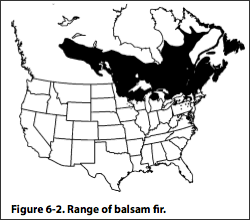Quick facts
- White spruce grows best on well-drained loam and clay.
- Balsam fir thrives on moist, well-drained sandy loam.
- Thinning promotes healthy and vigorous trees.
- Harvest a stand’s balsam fir and aspen when they mature to encourage spruce growth.
- Spruce budworm, heart rot and root rot, and wind are all causes of damage to spruce-fir forests.
White spruce and balsam fir are often found growing in similar stands and conditions. And they regenerate in similar ways.
White spruce and balsam fir are mainly used for pulpwood and small sawtimber.
Spruce-fir stands provide a habitat for grouse, songbirds, white-tailed deer, moose and a variety of small mammals.
Growing conditions
White spruce often forms pure stands, but you may find it mixed with black spruce, balsam fir, aspen and paper birch.
Balsam fir is often found mixed with a wide variety of other species, including black spruce, white spruce, paper birch, quaking aspen, bigtooth aspen, yellow birch, American beech, red maple, sugar maple, eastern hemlock, eastern white pine, tamarack, black ash and northern white cedar.
Stands that develop after a major disturbance such as fire, insect attack or clear-cutting will be the same or nearly the same age (known as even-aged). Because white spruce and balsam fir are shade-tolerant, uneven-aged stands will develop over time if there aren’t any disturbances.
- White spruce and balsam fir grow on a wide variety of soils.
- White spruce does best on well-drained loam and clay.
- Balsam fir grows best on moist, well-drained sandy loam.
- The spruce-fir cover type is common on well-drained lowlands, where there’s less competition from hardwoods.
Regenerating white spruce and balsam fir
- A rotation is the number of years required to establish and grow trees to a desired size, product or maturity.
- White spruce may be grown on 80- to 120-year rotations for sawlogs.
- To minimize pest damage, manage fir on a 40- to 50-year rotation.
White spruce and balsam fir regularly produce good seed crops and often are regenerated by natural seeding. Almost any moist seedbed will work, but bare mineral soil with some shade is best.
You can manage spruce-fir stands under the selection system. Under this system, you’d harvest trees individually or as a group so there’s room for natural regeneration.
If you want to produce even-aged stands, a shelterwood cut or strip clear-cut is recommended. A shelterwood cut partially harvests trees so new stems can grow up under an overstory of maturing trees, while clear-cutting would remove the entire strip at once.
Using smaller cutting blocks surrounded by seed-producing trees:
- Allows for good seed dispersal.
- Reduces the chance that surrounding trees will get uprooted by wind.
- Produces a mixed-age stand less susceptible to a spruce budworm attack.
If you want natural spruce regeneration, expose mineral soil. Full-tree skidding usually will expose enough mineral soil for natural seeding unless the ground is frozen.
When planting white spruce seedlings, first remove heavy slash concentrations (woody debris left after logging, pruning, thinning or brush cutting). Plant 600 to 1,000 seedlings per acre.
Transplant stock is best, but because of its high cost, woodland managers often use 3-0 seedlings (seedlings grown at a nursery for three years without transplanting) or container-grown stock.
Balsam fir often isn’t planted because there’s low market demand and it’s relatively easy to regenerate by natural seeding.
Intermediate treatments
Thinning can be used to promote healthy and vigorous trees. Starting at age 25 to 30, thin the stand every 15 to 20 years to a basal area of about 90 square feet per acre. Basal area measures stand density using the sum of trees’ cross-sectional areas at 4.5 feet from the ground (known as breast height).
To encourage spruce growth, harvest the stand’s balsam fir and aspen when they mature (age 60).
Pest management
The eastern spruce budworm is the major insect pest of the spruce-fir forest type. It survives best on older trees. Balsam fir is more susceptible to spruce budworm damage than white spruce.
To minimize damage:
- Manage fir on a 40- to 50-year rotation.
- Keep large forest areas well-diversified, with trees of many ages and sizes.
- Maintain a high spruce and hardwood component.
You may need insecticides in areas where there’s a prolonged budworm attack.
Heart rot and root rot are major diseases. To minimize them:
- Keep budworm from killing treetops (you may need insecticides).
- Avoid scarring residual stems during intermediate cuttings.
Wind uprooting trees can be a serious condition, especially on wet, shallow soils. To minimize windthrow, maintain a well-stocked, vigorous stand.
Reviewed in 2018



